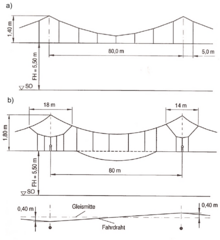Chain suspension

As a chain suspension or catenary one of the possible is catenary constructions in electric railways with overhead line or trolley buses , respectively. Its construction goes back to the year 1902, when the AEG carried out the first test operation with single-phase alternating current on the branch line Schöneweide – Spindlersfeld .
Compared to other electric railways, the catenary system differs in that the contact wire is suspended on one or two chains at a distance of three meters. This construction method is justified by the fact that in the event of a wire break, the end of a broken wire does not hang more than 2.5 meters above the upper edge of the rail (SOK), thus avoiding the risk of electric shock for the railway staff. The suspension ropes were not insulated from the start, so the power supply for the other sections was still guaranteed in the event of a wire break. Only the longitudinal wires are double insulated on the mast crossmember. As a result, they are secured against the earth there, and the cross beams are also secured against the mast with additional insulators .
Compared to this basic design, there is no significant difference to be found in comparison to catenaries of today, only the components have changed. Today, wooden poles are no longer common and the shape and materials of the insulators have changed. In the case of the first execution in Niederschöneweide, it is not clear from the literature whether and how the ropes were guyed. In the so-called unit line that emerged later from 1925 to 1942, only the contact wire was guyed, but not the tethers. Only then did the holding ropes be braced. The booms also changed several times; While they were still attached horizontally to the mast at Niederschöneweide-Spindlersfeld , the cast iron brackets on the overhead lines at the time of the DRG are statically more favorably attached to the mast at an angle and carried the tether. The contact wire was attached to a horizontal arm on the mast. Occasionally some Y-ropes were added at the place of the masts.
The limits of this type of construction resulted from the further increasing speed of the electrically hauled trains. The suspension could not follow the temperature-related expansion of the contact wire, and so the contact lines are now made with swivel tube booms , where the booms for the tether are swiveled to the mast, and the tube boom for the contact wire is also swiveled on it. This means that driving and holding wires can both be tensioned, so that higher speeds can be achieved. The insulators are now arranged directly on the joint and are therefore no longer exposed to the smoke gases from the steam locomotives.
literature
- F. Eichberg: Collected electrical engineering work 1897–1912. Springer Verlag, Berlin 1914.
- Henning Folz: Historical overhead lines at the DB in Eisenbahn-Kurier 7/2009, EK Verlag Freiburg, pages 58-60

